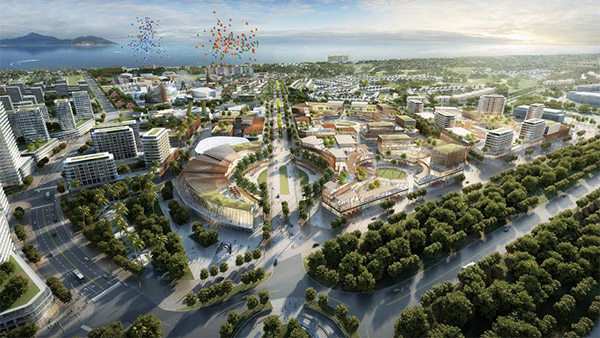Stock
commercial
- EXCHANGE
- GOLD RATIO
Stalling projects attract foreign investors
12:00 | 04/10/2017
Foreign investment capital continues to flow into the Vietnamese real estate market as foreign investors are actively acquiring suspended projects.
 |
| After being left undeveloped for four years, the project was revived by the entrance of Chow Tai Fook |
According to Jones Lang Lasalle (JLL), capital inflows into the real estate market show no signs of slowing down thanks to market stability and opening-up to foreign investors. In addition to investors from Japan, Singapore, and Thailand, Chinese investors have injected millions of dollars into the market, especially long-delayed developments.
Notably, Hong Kong-based Chow Tai Fook Enterprises Ltd. has become the main investor in South Hoi An casino project. Licensed in 2010, the project was initially developed by VinaCapital and Genting Group with an investment capital of $4 billion.
However, the project was delayed for years to find a suitable partner when Genting announced its withdrawal. After being left undeveloped for four years, the project was revived with the entrance of Chow Tai Fook.
In 2014, Chow Tai Fook has explored possibilities of implementing the project and conducted negotiations with VinaCapital. Chow Tai Fook has formed a partnership with Macau-based SunCity Group to acquire a controlling stake in the project.
In 2015, Do Xuan Dien, director of the Management Authority of the central province of Quang Nam's Chu Lai Open Economic Zone, confirmed that SunCity Group and Chow Tai Fook Enterprises Ltd. replaced Genting for the proposed $4-billion integrated casino resort.
Meanwhile, Hong Kong’s Summerfield Co., Ltd. expressed interest in the Happy Land entertainment complex in the Mekong Delta province of Long An. The complex can be reached via National Highway 1A and the Ho Chi Minh City-Trung Luong Expressway.
Phu An held the ground-breaking ceremony for the project in 2011. The first phase was set to be carried out on an area of 338 hectares at a cost of $2 billion. The second phase would cover 580ha. Under the initial plan, the complex would be open to the public from April 2014. However, it was not until April 2016 that the first premise, a racing track, was inaugurated.
In addition, China Fortune Land Development Group has bought shares in VinaCapital’s Lotus Dai Phuoc project for $65.3 million. Dai Phuoc Lotus is a residential area project with a total area of 198.5 million hectares in Dong Nai province, bordering Ho Chi Minh City.
China Fortune Land Development Group also showed ambition in the market when entering a partnership with Tin Nghia Corporation to develop East Sai Gon Urban Area and Ong Keo Industrial Zone in Dong Nai in September 2016.
Another investor Hong Kong Land spent $95 million acquiring 64 per cent of the stakes in a residential housing project in Thu Thiem New Urban Area from Ho Chi Minh City Infrastructure Investment Joint Stock Company (CII).
Hongkong Land and SonKim Land in Ho Chi Minh City are developing The Nassim luxury condominium in Thao Dien in District 2 of Ho Chi Minh City.
One notable trend is that foreign investors tie up with local partners to resume long-delayed projects. After receiving $200 million from Creed Group from Japan, An Gia Investment has completed its takeover of six projects. Most recently, the company has acquired seven blocks in Lacasa project in District 7 from Van Thinh Phat. An Gia Investment bought two blocks in March 2015 and then acquired the remaining five blocks in the second phase.
Lacasa has been revived after being frozen for nearly a decade. Some new projects, like Angia Riverside and Angia Skyline, have recorded healthy take-up rates of 90 per cent for 800 apartments in total. An Gia has also resumed a number of projects, including The Garden, River City, and most recently River Panorama.
Mergers and acquisitions (M&A) activity remains robust in Ho Chi Minh City’s real estate market. By M&A, developers can save a lot of time in completing legal procedures, as well as dealing with site clearance and compensation. While the housing market is strong, developers can shorten project development and quickly launch products to get returns.
Nguyen Tran Nam, chairman of the Vietnam Real Estate Association (VNREA), said that, “The increasing acquisitions among major developers can bring several benefits. The acquirer will save time in completing procedures and cut expenses to develop new projects, while the seller will solve financial issues. On top of this, the revival of delayed projects will help resolve inventory problems in the market.”
However, some foreign investors failed to develop suspended projects after having them transferred, such as the Binh Quoi-Thanh Da project. The project was approved by the Ho Chi Minh City People’s Committee back in 1992. In 2004, Saigon Construction Corporation was selected as the project investor. However, in 2010, the city decided to take the project away from this investor.
In late 2015, Bitexco Group partnered with Emaar Properties PJSC to establish a joint venture to take over the project. After Emaar officially quit the project in October 2016, Bitexco has been assigned as the investor of the urban project. Bitexco’s appointment is expected to end the almost 20-year log-jam in development.
There are around 500 real estate projects in Ho Chi Minh City and a hundred projects in Hanoi that have been delayed for years. These are opportunities for developers and foreign investors to strike up more deals in the coming time.
Phan Xuan Can, chairman of Soho Vietnam, noted that real estate projects are left idle for various reasons like design mistakes, wrong positioning, and ineffective marketing. Some projects are currently held as collateral for bad debts or their previous developers lack financial capacity. Thus, the acquirers should take a new approach to redesign and alter the pricing and marketing to improve project liquidity.
Thanh Vân
VIR










